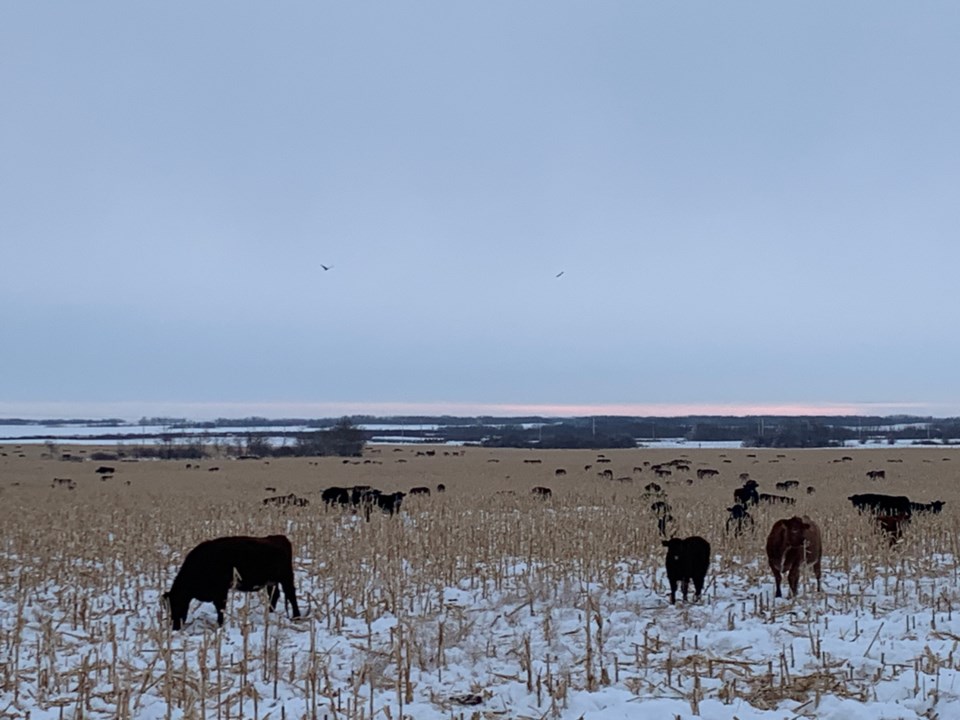STOUGHTON - The Goudys have been on the family farm for many years.
It is the original Goudy homestead which has been in the family since 1906. Graham and Val raised their two sons John and Brett on the farm north of Stoughton.
Brett Goudy and his wife Crystal, and three children Sianna, Jaxon and Cash, along with John and Julia Goudy and their children Carley, Madison, Reid, Colton and Kierra, all are part of Century Lane Farms. They also have a sister, Melisa, who is married and has two children, but they are not actively involved in the farm.
Brett said it all began with his great grandparent’s farm and Brett’s parents are third generation farmers. His dad, Graham, was raised on this farm and today is still actively involved in the farm, although is slowing down some.
Although Brett and his brother John both work off the farm, they too are incredibly involved in farm life.
The farm has over 300 head of shorthorn cross cows. They also have 20 bulls, which are purebred shorthorns, black angus and Simmentals.
Brett feels the shorthorn cross cattle fit well into the environment here. The cows are very fertile and good breeders, which leaves few cows to remain open after breeding season is done.
Heifers are bred for the first time at approximately 15 months and can remain in production until they are up to 16 years of age. Cows and heifers are pregnancy checked after the breeding season and will be culled if they are not confirmed to be in calf.
Aggressive cows are not kept, as they can also agitate the herd and it makes for a dangerous situation said Brett, especially around young children, so they are sold, along with cows with bad feet and bad utters.
At one time they calved in March or April, but the weather is unpredictable at that time of year, so they slowly began to breed later for calving to begin in the second week in May. This way the cows would calf on grass. Not only is it easier on the cows, but Goudy also said it is easier on Julia.
Julia and Graham complete the majority of the day-to-day farm activities, including calving. Brett said, Julia and Graham work extremely hard on the farm and do a lot with the cows and calves, since both brothers work off the farm full time.
Although they calf in May, nightly checks are always done during this time, to ensure there are no difficulties in the herd. As seeding time is the same time as calving, Julia and Graham also bring the seed and fertilizer to the fields and haul water to the sprayer. Brett, John and Reid complete the majority of the spring field work between off the farm work and school.
When a cow has twins, they are brought to the corrals to make sure both calves are nursing well, and the cow excepts both of her babies.
Calving in May decreases the chances of scours and pneumonia in calves, and Brett said they do not have any issues with calving at this time of the year, as the weather is warmer, and they are on pasture.
Calves are weaned in December or January and fed grain and quality hay to ensure nutrition remains in the calves. The calves are backgrounded until spring at which time they are sold or depending on pasture availability, they might be sold in September.
Over the winter Goudy’s herd will primarily graze on standing corn and be supplemented with brome/alfalfa/clover hay. They may also swath graze, put up silage or feed green feed depending on supplies.
Stockpile grazing is another method of feeding, along with a cover crop. Feeding this way saves on hay, while still receiving the value in the feed that cattle need.
One cow will eat an equivalent of six large round bales of hay over the winter, which is why the Goudys need 1,800-2,000 round bales of hay to sustain the herd, which they bale off of their own and rented land.
During the summer months the cattle remain on grass and rotate from pasture to pasture so as not to overgraze the land.
They keep around 50 replacement heifers from their calves to increase the quality of the herd.
The Goudys are working towards holistic management for the farm. Brett said it is important to have good soil, but the soil also needs to be healthy, then in turn receive good crops.
Canola, barley, oats and corn are all part of seeding in the spring.
“Our equipment is not new, but it works well and that is all that matters,” said Brett.
They also plant a cover crop which too is good for the land.
The Goudy clan is happy to be farming, wants to be more sustainable in the future and will strive for these results as a family team.





